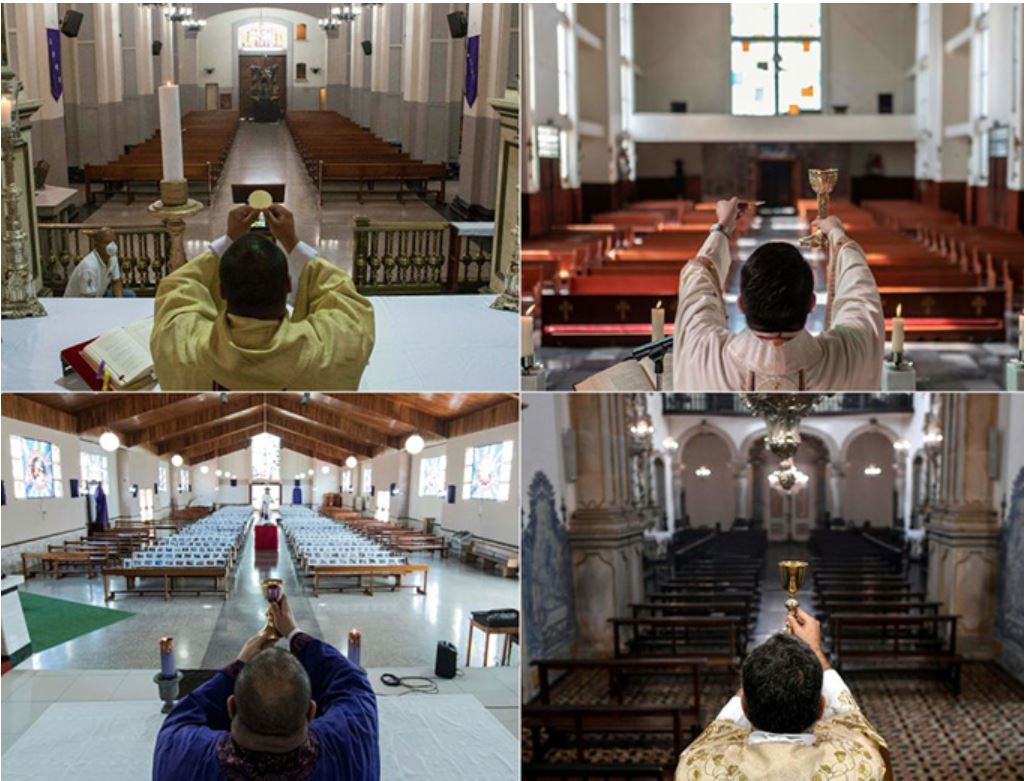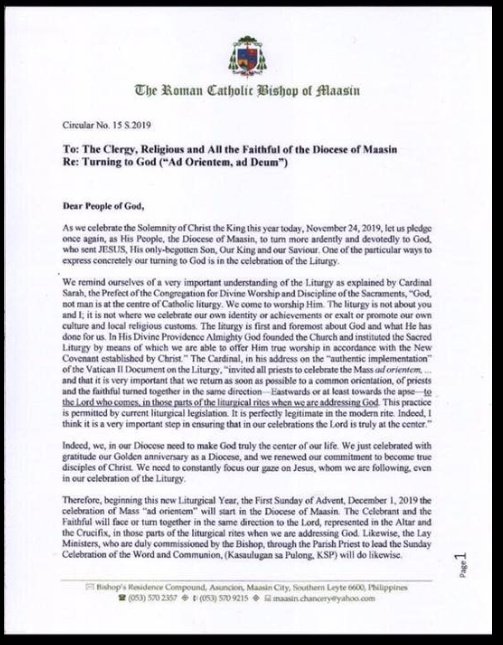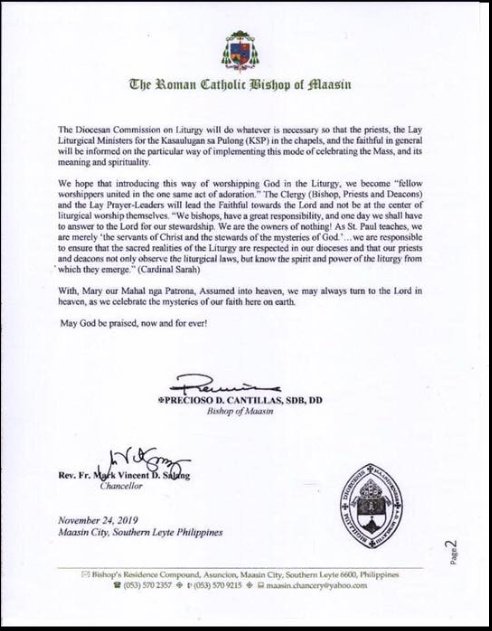
Go ad orientem!
Auxilia ad Missam in forma ordinaria celebrandam secundum Œcumenicum Concilium Vaticanum II

Go ad orientem!
Ils ne sont pas «tradis», n’ont pas adopté la forme extraordinaire du rite romain, mais célèbrent pourtant de temps à autre la messe ad orientem. Traduisez « tournés vers Dieu ».
Devant le mystère de Dieu, il faut rester humble, et la meilleure façon de l’être est de se tourner face au Seigneur.
(…)
Lorsque le prêtre est face à Dieu, il est comme un premier de cordée qui nous emmène vers le sommet. C’est plus vertical.
Reportage ici.
Videocatechesi dell’amico don Marino Neri sull’orientamento dell’altare nella liturgia. Sullo stesso argomento vedi questo post.
La Messa è tutto, ho scritto e sostenuto più volte. Chi potrebbe dubitarne?
Ora preciso che essa è tutto purché sia quale dev’essere, in piena sintonia col dogma e la grande Tradizione liturgica intesa nel contesto dei documenti del Magistero.
Se non è necessario tornare alla Messa di S. Pio V, è gravemente doveroso che almeno l’attuale – o della riforma di Paolo VI – sia celebrata secondo lo spirito del Concilio e le norme vigenti, rispettate dai migliori sacerdoti.
Il popolo non vuole altro.
Come riconosce alla S. Sede il dovere di modificare la liturgia, perché risponda sempre meglio alle esigenze del culto; così non tollera arbitri, errori, profanazioni. E si sente pienamente compreso quando lo stesso card. Ratzinger leva alta la sua protesta contro certe prevaricazioni colpevolmente autorizzate da Vescovi e parroci sprovveduti o malintenzionati.
«Dopo il Concilio – egli denunzia -, molti elevarono coscientemente a livello di programma la desacralizzazione…; si sono abbandonati i paramenti sacri, si sono spogliate le chiese più che si è potuto di quello splendore che ricorda il sacro, e si è ridotta la liturgia al linguaggio e ai gesti della vita ordinaria, per mezzo di saluti, segni comuni di amicizia e cose simili…
«Si è dimenticato che questo mondo non è il regno di Dio e che il Santo di Dio continua ad essere in contraddizione con il mondo.
«La liturgia non è un festival, non è una riunione di svago…
«Gli uomini si sentono ingannati quando il “mistero” si trasforma in distrazione, quando l’attore principale nella liturgia non è il Dio vivo, ma il sacerdote o l’animatore liturgico…» (Disc. ai Vescovi del Cile, 16 luglio 1988).
È quanto ancora si ripete all’insegna dl una “creatività” che va banalizzando il culto, screditando il sacerdozio cattolico, estinguendo la fede del nostro buon popolo.
Che i fedeli, informati di tutto, ne siano consapevoli e sappiano reagire contro qualsiasi usurpazione dl un patrimonio di valori che, essendo della Chiesa, ciascuno ha il dovere-diritto di conservare e difendere.
(Don Enrico Zoffoli, Questa è la Messa. Non altro! – Edizioni Segno 1994 – pp. 106-115 – PDF)
Der afrikanische Kurienkardinal Robert Sarah hat sich für die Zelebration der heiligen Messe „ad orientem“ ausgesprochen. Bei der offiziellen Präsentation der deutschen Ausgabe seines aktuellen Buches „Herr, bleibe bei uns“ in der Benediktinerabtei St. Georg in Weltenburg erklärte Sarah wörtlich: „Ich habe das schon oft vorgeschlagen. Denn die Kirche hatte immer Richtung Osten gebetet.“
„Wenn man das Kreuz in die Mitte des Altares rückt und sich alle Blicke auf das Kreuz richten, dann ist das, als bete man ,ad orientem‘, da Jesus Christus der christliche Orient ist.“
Né il Concilio ha imposto la celebrazione verso il popolo, né ha dichiarato l’inabilità degli altari storici, né ha ordinato una vicinanza fisica all’assemblea ottenuta ad ogni prezzo. Si tratta allora di uscire dal pregiudizio così diffuso nel postconcilio e di ripensare ad una opportuna riconciliazione.
Credo che non sia possibile, relegare nell’inutilità e nell’abbandono i grandi altari storici, ma la liturgia stessa ne avrebbe giovamento se, rispettando dovutamente e intelligentemente il genio e la tipologia della diverse chiese si celebrasse in modo diversificato. Allora non vi sarà frattura, ma continuità e, soprattutto, si potrà uscire da quella situazione provvisoria di altari fragili e inadatti, che da decenni ormai occupano le zone presbiterali.
Leggi l’articolo completo di don Enrico Finotti qui.
Many of those, especially young adults, who frequent the extraordinary form of the Roman Rite, celebrated according to the 1962 ritual that stretches back to the Council of Trent, do so, in my opinion, not because they have major issues with the Novus Ordo — per se — but because they prefer the general liturgical fidelity and reverence of priests who celebrate the extraordinary form, the conspicuous focus on God, the sacred music, the way Holy Communion is received, the promotion of priestly vocations through the training of altar boys, and several other things still possible, but far less common, in the celebration of the Novus Ordo.
To celebrate the Novus Ordo “as it ought to be” means ensuring always and everywhere that the liturgy conveys a profound sense that one is in God’s presence, facilitates loving God with all our heart, mind, soul and strength, and opens us up so that God can transform us by this encounter to love our neighbor as he loves us.
This not only can happen, but does, when the celebration of the Novus Ordo takes place with proper preparation, beauty and reverence.
That’s what every Catholic has a right to. That’s what St. Paul VI intended. That’s what the Church and the world need.
Fr. Roger Landry, Diocese of Fall River, Massachusetts, on National Catholic Register.
Beginning this new Liturgical Year, the First Suday of Advent, December 1, 2019 the celebration of Mass “ad orientem” will start in the Diocese of Maasin. The Celebrant and the Faithful will face or turn together in the same direction to the Lord, represented in the Altar and the Crucifix.


Holy Mass (Novus Ordo) today (11-17-19) at St. Mary of Pine Bluff. The church was filled with young devout families.
Enquanto o sacerdote se coloca na frente do altar, ele não reza em direção a uma parede, mas conjuntamente reza com todos em direção ao Senhor, tanto mais porque o que importava até agora não era formar uma comunidade, mas render culto a Deus por intermédio do sacerdote, representante dos participantes e unido a eles.
Por isto, falando da direção da oração, Santo Agostinho, bispo de Hipona, escreve: “Quando nos levantamos para orar, voltamo-nos para o Oriente (ad orientem convertimur) de onde o céu se levanta. Não que Deus só se encontre ali, ou que tenha abandonado as outras regiões da terra… mas para exortar o espírito a se voltar para uma natureza superior, ou seja, a Deus”.
Isto explica porque os fiéis, depois do sermão, se levantavam de seus assentos para a oração, que seguia, e se voltavam para o oriente. Santo Agostinho os convidada para isso freqüentemente ao terminar seus sermões, utilizando, à maneira de frase já consagrada, as palavras: “Conversi ad Dominum” (voltados para o Senhor!).
Aqui se pode evocar uma palavra de São Paulo. Consciente de que “todo o tempo que passamos no corpo é um exílio longe do Senhor. Andamos na fé e não na visão”, ele deseja estar ausente “deste corpo para ir habitar junto do Senhor” (ad Dominum) (2Cor 5,6-8).
Assim, pois, voltar-se para o Senhor e olhar para o Oriente, para a Igreja primitiva era uma única e mesma coisa.
Monsenhor Klaus Gamber, Voltados para o Senhor!
Traduzido por Luís Augusto Rodrigues Domingues